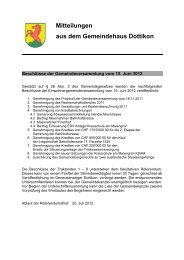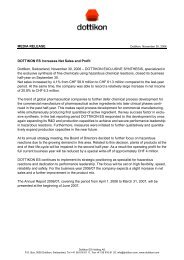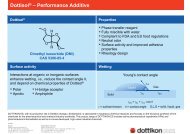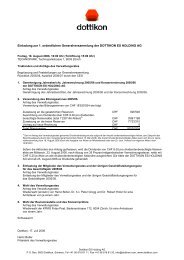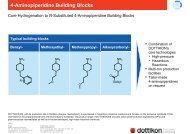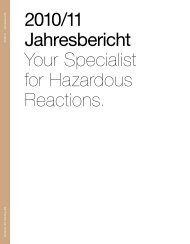pdf file - Dottikon
pdf file - Dottikon
pdf file - Dottikon
You also want an ePaper? Increase the reach of your titles
YUMPU automatically turns print PDFs into web optimized ePapers that Google loves.
38 Notes DOTTIKON ES Group Annual Report 2011/12<br />
gains and losses are included in the operating income or expenses<br />
together with the hedged change in fair value of the<br />
underlying asset or liability. Changes in fair value of derivatives<br />
to hedge cash flows are recognized in other comprehensive<br />
income (cash flow hedge according to IAS 39). If an expected<br />
transaction or firm commitment results in the recognition of<br />
an asset or liability, the gains or losses previously recognized<br />
in other comprehensive income are included in the initial<br />
measurement of the asset or liability.<br />
Intangible assets<br />
The position intangible assets includes software acquired from<br />
third parties. They are measured at cost of acquisition less<br />
economically required amortization. Intangible assets are<br />
amortized on a straight-line basis over their expected economic<br />
useful lives, which is usually between 4 and 7 years.<br />
Any impairment loss is recognized in profit or loss.<br />
Property, plant and equipment<br />
Property, plant and equipment is measured at cost of acquisi-<br />
tion or conversion less economically required depreciation<br />
and impairments. None of these items are financed with leasing<br />
agreements. The items of property, plant and equipment are<br />
depreciated on a straight-line basis over their expected economic<br />
useful lives, except for land, which is not depreciated,<br />
and items under construction, which are only depreciated from<br />
their commissioning date.<br />
The estimated useful lives for the main categories of depreciable<br />
property, plant and equipment are as follows:<br />
Buildings 20 to 50 years<br />
Technical plant and machinery 5 to 35 years<br />
Other property, plant and equipment 3 to 15 years<br />
Where components of larger assets have different useful lives,<br />
they are depreciated separately. Useful lives and residual<br />
values are reviewed annually at the balance sheet date and<br />
any adjustments recognized in the income statement. All gains<br />
or losses arising from disposal of items of property, plant and<br />
equipment are recognized in profit or loss. Items of insignificant<br />
value are not recognized in the balance sheet and therefore<br />
directly charged to the income statement.<br />
Recoverability of non-current assets/impairment<br />
The recoverability of non-current assets is tested as soon as<br />
events or a change in circumstances indicate that the carrying<br />
amount may exceed the recoverable amount. An impairment<br />
loss is recognized for the excess of the carrying amount of the<br />
asset over the recoverable amount. This results in the asset<br />
being recognized at the higher amount of fair value less costs<br />
to sell and value in use. If cash flows cannot be directly allocated<br />
to individual assets, the impairment is determined on a<br />
higher level, which is the cash-generating unit to which the<br />
asset belongs. A cash-generating unit is the smallest identifiable<br />
group of assets that generates cash flows that are largely<br />
independent of the cash flows from other assets or groups<br />
of assets.<br />
39 Notes DOTTIKON ES Group Annual Report 2011/12<br />
Inventories<br />
Inventories comprise raw materials, supplies, trading goods<br />
as well as semi-finished and finished goods. They are measured<br />
– using the weighted average method – at the lower of<br />
cost of acquisition or conversion and net realizable value. Cost<br />
of conversion of inventories includes direct material and<br />
production costs and a part of attributable overhead costs.<br />
Slow-moving items are partly or fully adjusted in value.<br />
Trade receivables<br />
Trade receivables are measured at amortized cost, which<br />
generally equals the nominal value less value adjustments<br />
made for identifiable solvency risks based on the maturity<br />
structure. Besides individual value adjustments with respect<br />
to specific identifiable risks, value adjustments are also recognized<br />
based on statistically determined credit risks.<br />
Other receivables<br />
Other receivables are measured at amortized cost, which<br />
generally equals the nominal value. Other receivables comprise<br />
other receivables from third parties, current loans with<br />
a maturity of less than 12 months, prepayments of expenses<br />
and income that can only be realized in the following year.<br />
Current financial assets<br />
Current financial assets are measured at nominal values. Cur-<br />
rent financial assets comprise fixed deposits with an original<br />
maturity of more than 90 days since date of acquisition.<br />
Cash and cash equivalents<br />
Cash and cash equivalents are measured at nominal values.<br />
They comprise cash on hand and bank accounts as well as<br />
fixed deposits with an original maturity of up to 90 days since<br />
date of acquisition.<br />
Non-current liabilities<br />
Non-current liabilities comprise all identified liabilities at the<br />
balance sheet date that can be measured reliably and that<br />
have a maturity of more than 1 year after balance sheet date.<br />
Current liabilities<br />
Current liabilities include all liabilities that are due within 12<br />
months.<br />
Trade payables and other current liabilities<br />
Trade payables and other current liabilities are measured at<br />
amortized cost, which generally equals the nominal value.<br />
Research and development<br />
Research costs are charged to the income statement in the<br />
period they occur. Development costs are only capitalized<br />
when certain criteria are met and the capitalized amount is<br />
covered by future economic benefits.



